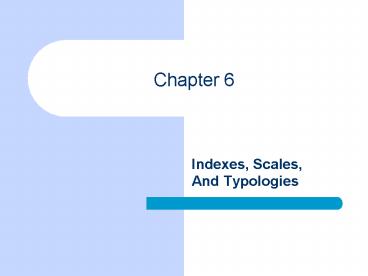Indexes, Scales, And Typologies - PowerPoint PPT Presentation
1 / 13
Title:
Indexes, Scales, And Typologies
Description:
Chapter 6 Indexes, Scales, And Typologies Chapter Outline Indexes versus Scales Index Construction Scale Construction Index and Scale Similarities: Both are ordinal ... – PowerPoint PPT presentation
Number of Views:51
Avg rating:3.0/5.0
Title: Indexes, Scales, And Typologies
1
Chapter 6
- Indexes, Scales, And Typologies
2
Chapter Outline
- Indexes versus Scales
- Index Construction
- Scale Construction
3
Index and Scale
- Similarities
- Both are ordinal measures of variables.
- Both rank order units of analysis in terms of
specific variables. - Both are measurements based on more than one data
item.
4
Index and Scale Scoring Differences
- Index accumulate scores assigned to individual
attributes. - Scale assign scores to patterns of responses.
5
Constructing an Index
- Select items for a composite index.
- Examine empirical relationships.
- Assign scores for responses.
- Handle missing data.
- Validate the index.
6
Selecting Items
- Criteria
- Face (logical) validity
- Unidimensionality
- General or specific
- Variance
7
Empirical Relationships
- Established when respondents answers to a
question help predict how they will answer other
questions. - If two items are empirically related, we can
argue that each reflects the same variable, and
both can be included in the same index. - Bivariate relationships - relationships between
2 variables. - Multivariate relationships - relationship
between more than 2 variables.
8
Assign Scores for Responses
- Two basic decisions
- Decide the desirable range of the index scores.
- Decide whether to give each item in the index
equal weight or different weights.
9
Ways to Handle Missing Data
- Exclude cases with missing data from the
construction of the index and the analysis. - Treat missing data as one of the available
responses. - Analyze missing data to interpret the meaning.
10
Validate the Index
- Item Analysis - internal validation.
- External validation - ranking of groups on the
index should predict the ranking of groups in
answering similar or related questions.
11
Techniques of Scale Construction
- Bogardus social distance scale - measures the
willingness of people to participate in social
relations. - Thurstone scales - judges determine the intensity
of different indicators.
12
Techniques of Scale Construction
- Likert scaling - uses standardized response
categories. - Semantic differential -asks respondents to rank
answers between two extremes. - Guttman scaling - uses an empirical intensity
structure (most common).
13
Typologies
- Summarize the intersection of two or more
variables to create a set of categories or types. - Typologies are often created in an attempt to
construct an index or scale the items you felt
represented a single variable appear to represent
two. - It is extremely difficult, to analyze a typology
as a dependent variable.

